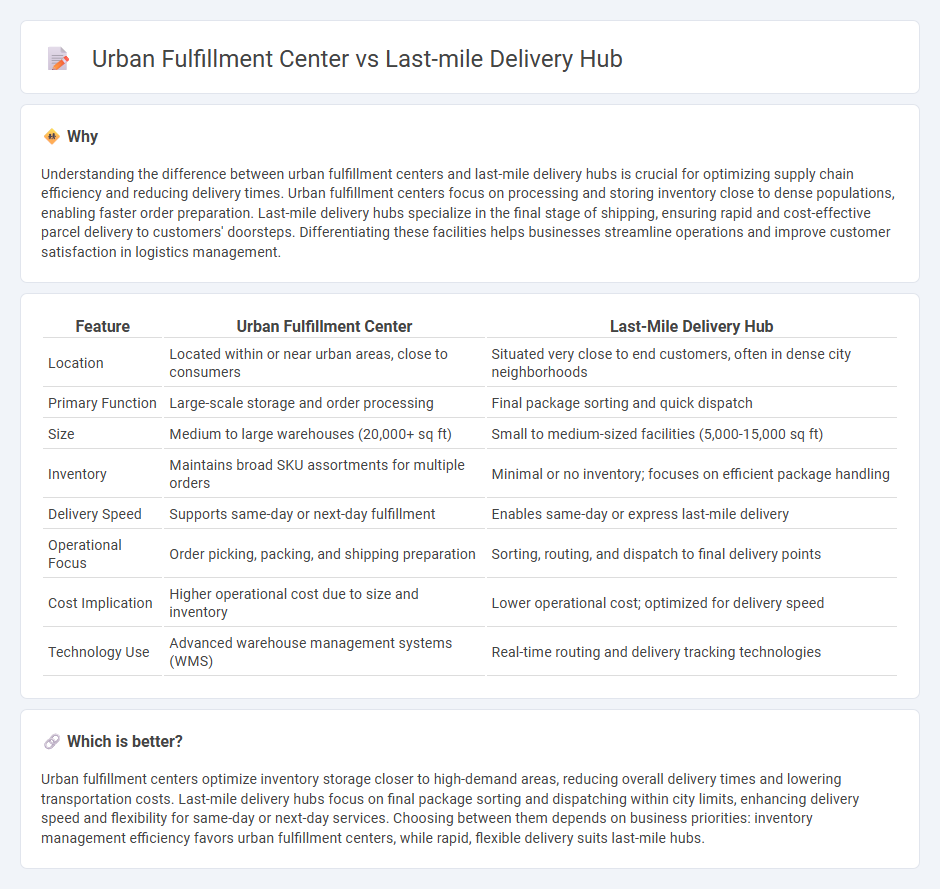
Urban fulfillment centers are strategically located warehouses designed to store and rapidly process inventory close to dense metropolitan areas, optimizing order picking and packaging efficiency. Last-mile delivery hubs serve as local distribution points focused on rapid parcel sorting and dispatch to final customer destinations, minimizing delivery times within crowded urban settings. Explore the differences and synergies between these logistics solutions to enhance supply chain efficiency.
Why it is important
Understanding the difference between urban fulfillment centers and last-mile delivery hubs is crucial for optimizing supply chain efficiency and reducing delivery times. Urban fulfillment centers focus on processing and storing inventory close to dense populations, enabling faster order preparation. Last-mile delivery hubs specialize in the final stage of shipping, ensuring rapid and cost-effective parcel delivery to customers' doorsteps. Differentiating these facilities helps businesses streamline operations and improve customer satisfaction in logistics management.
Comparison Table
| Feature | Urban Fulfillment Center | Last-Mile Delivery Hub |
|---|---|---|
| Location | Located within or near urban areas, close to consumers | Situated very close to end customers, often in dense city neighborhoods |
| Primary Function | Large-scale storage and order processing | Final package sorting and quick dispatch |
| Size | Medium to large warehouses (20,000+ sq ft) | Small to medium-sized facilities (5,000-15,000 sq ft) |
| Inventory | Maintains broad SKU assortments for multiple orders | Minimal or no inventory; focuses on efficient package handling |
| Delivery Speed | Supports same-day or next-day fulfillment | Enables same-day or express last-mile delivery |
| Operational Focus | Order picking, packing, and shipping preparation | Sorting, routing, and dispatch to final delivery points |
| Cost Implication | Higher operational cost due to size and inventory | Lower operational cost; optimized for delivery speed |
| Technology Use | Advanced warehouse management systems (WMS) | Real-time routing and delivery tracking technologies |
Which is better?
Urban fulfillment centers optimize inventory storage closer to high-demand areas, reducing overall delivery times and lowering transportation costs. Last-mile delivery hubs focus on final package sorting and dispatching within city limits, enhancing delivery speed and flexibility for same-day or next-day services. Choosing between them depends on business priorities: inventory management efficiency favors urban fulfillment centers, while rapid, flexible delivery suits last-mile hubs.
Connection
Urban fulfillment centers and last-mile delivery hubs form an integrated network that streamlines the flow of goods from storage to customer doorstep. Urban fulfillment centers store inventory closer to dense consumer areas, reducing delivery times and shipping costs, while last-mile delivery hubs serve as final distribution points that dispatch orders efficiently within metropolitan zones. This connection enables faster order processing, improved delivery speed, and enhanced customer satisfaction in e-commerce logistics.
Key Terms
**Last-mile delivery hub:**
Last-mile delivery hubs are strategically located facilities designed to streamline the final phase of parcel delivery, enabling faster and more efficient customer service in densely populated urban areas. These hubs focus on reducing delivery times by minimizing the distance between packages and recipients, leveraging real-time data and local transportation networks for optimal route planning. Discover how last-mile delivery hubs transform urban logistics and enhance customer satisfaction.
Route optimization
Last-mile delivery hubs specialize in optimizing routes for rapid, localized deliveries by strategically positioning packages closer to end customers, reducing transit times and costs. Urban fulfillment centers enhance route optimization by leveraging real-time data and advanced algorithms to streamline multi-stop deliveries within dense metropolitan areas. Explore how cutting-edge route optimization technologies transform delivery efficiency in both last-mile hubs and urban fulfillment centers.
Localized distribution
Last-mile delivery hubs prioritize rapid, localized distribution by strategically positioning inventory close to end customers, minimizing delivery times and addressing urban congestion challenges. Urban fulfillment centers typically handle larger inventory volumes and more complex order processing within city limits, enabling efficient bulk storage and speedy fulfillment for densely populated areas. Explore how leveraging both solutions can optimize your localized last-mile delivery strategy.
Source and External Links
What Is Last-Mile Hub Tracking? - Wise Systems - A last-mile hub is a local distribution center where packages are scanned, sorted, and tracked before drivers deliver them directly to customers, enabling real-time visibility and optimized delivery routes to improve efficiency and customer experience.
C.9 - Last Mile Facilities | The Geography of Transport Systems - Last-mile delivery hubs, especially fast delivery hubs, supply local markets with high-demand goods, acting as fulfillment and distribution centers positioned in urban areas to speed up deliveries of parcels, groceries, and perishable items.
What is a Last-Mile Delivery Station? - Wise Systems - Last-mile delivery stations are local hubs receiving packages from larger distribution centers, where packages are sorted and dispatched efficiently to final delivery locations, enabling faster delivery times and improved accuracy closer to customers.
 dowidth.com
dowidth.com